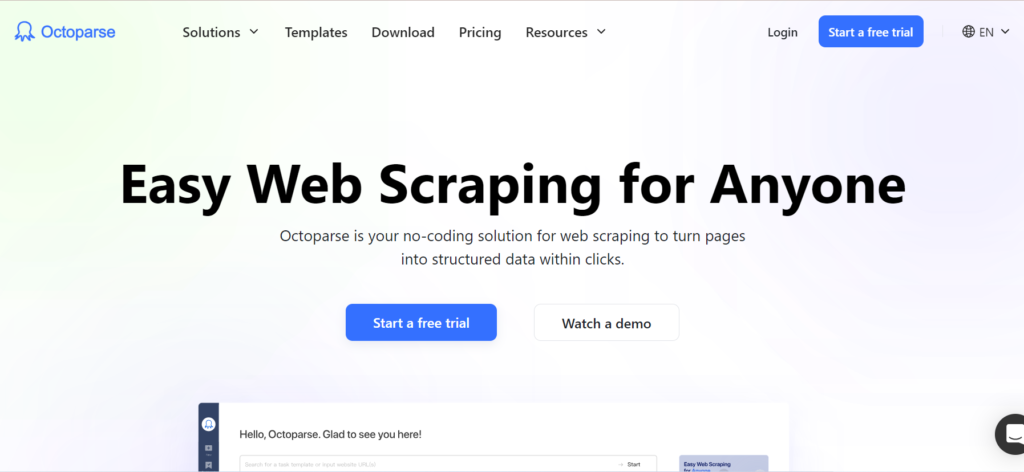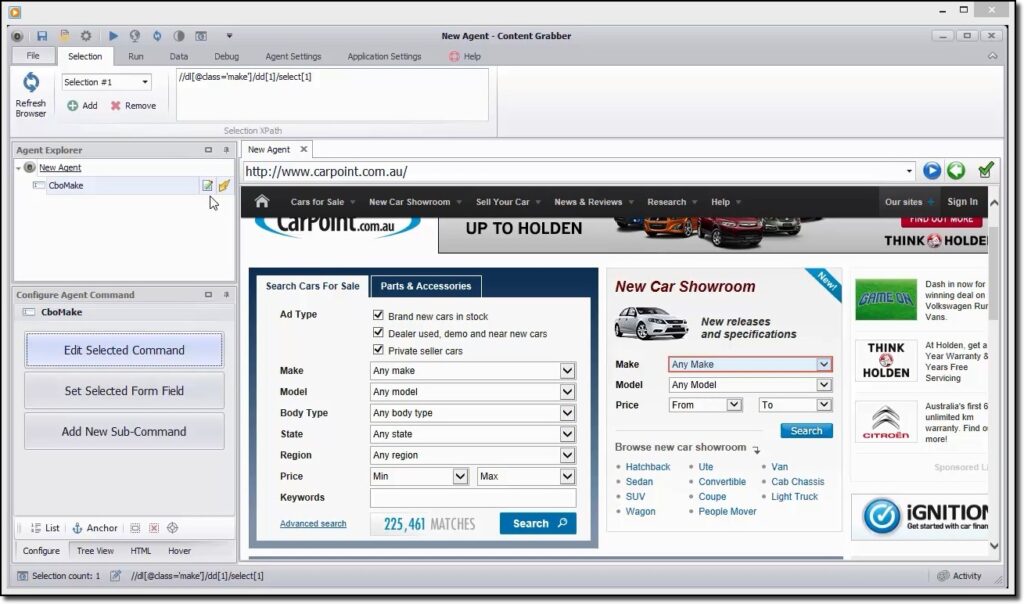First of all i will share a list of top 5 Web Scraping Tools
Here is the table with three columns:
| 1 | Octoparse | A cloud-based, no-coding web scraping tool with a drag-and-drop interface, ideal for beginners. |
| 2 | Scrapy | An open-source Python framework for developers, offering advanced customization for large-scale scraping. |
| 3 | ParseHub | A user-friendly, point-and-click tool that supports scraping dynamic content and JavaScript-based websites. |
| 4 | Content Grabber | An enterprise-level tool for large businesses, providing advanced automation and integration with APIs. |
| 5 | WebHarvy | A point-and-click software with automatic pattern detection, making it easy to extract data without coding. |
Best Web Scraping Tools in 2024
Web scraping is transforming the way businesses access and utilize online data. From automating tedious tasks to extracting insights for market research, web scraping has become an indispensable tool. In 2024, a wide variety of web scraping tools are available, each designed to cater to different needs. This comprehensive guide provides an in-depth look into the best web scraping tools, highlighting their features, use cases, and key benefits.
What is Web Scraping and Why It’s Important?
Web scraping involves extracting data from websites and structuring it into usable formats, such as spreadsheets or databases. This data extraction technique has grown significantly in importance as businesses look for ways to gather competitive intelligence, monitor market trends, and automate tasks. The ability to obtain large amounts of data efficiently provides companies with a competitive edge in decision-making processes.
Key Features of Top Web Scraping Tools
To choose the right web scraping tool, it’s essential to understand the key features that define a high-quality solution. The following features are crucial:
- Ease of Use: The best web scraping tools offer user-friendly interfaces that allow both technical and non-technical users to automate data extraction processes.
- Customization Options: Advanced customization enables users to set specific parameters for scraping, such as targeted elements, frequency, and export formats.
- Scalability: High-performing tools support scaling, allowing users to scrape large amounts of data across multiple websites.
- Data Accuracy: Accurate data extraction and formatting are critical to ensuring that the scraped data is usable.
- Compliance and Security: Tools should adhere to legal guidelines, ensuring that the scraping process respects website terms of service and data privacy regulations.
1. Octoparse

Octoparse is a cloud-based web scraping tool that allows users to automate the extraction of data without requiring any coding skills. Its intuitive drag-and-drop interface makes it accessible to beginners, while advanced users can utilize its powerful customization features. Octoparse is known for its scalability and ability to handle complex scraping tasks, making it ideal for businesses looking to extract large volumes of data.
- Key Features:
- No coding required
- Cloud-based for higher scalability
- Built-in data cleaning and structuring options
- Pre-built templates for common scraping tasks
2. Scrapy

Scrapy is an open-source and highly customizable web scraping framework built with Python. It provides extensive support for complex scraping tasks and is perfect for developers who need to create powerful scrapers that can handle large-scale data extraction projects. With Scrapy, users can build custom spiders for specific websites and extract data efficiently.
- Key Features:
- Open-source and free to use
- Highly customizable with support for custom spiders
- Extensive documentation and community support
- Powerful for large-scale scraping projects
3. ParseHub

ParseHub is a versatile tool that allows users to extract data from websites through an intuitive point-and-click interface. It supports JavaScript-based websites, making it a robust solution for scraping dynamic content. ParseHub’s cloud-based infrastructure also makes it scalable, enabling users to scrape data on-demand without the need for local resources.
- Key Features:
- User-friendly point-and-click interface
- Supports dynamic content and JavaScript-based websites
- Cloud-based scraping for enhanced scalability
- Automated workflows for recurring scraping tasks
4. Content Grabber

Content Grabber is an enterprise-level web scraping tool designed for large businesses and data professionals. It offers advanced automation capabilities and supports the creation of custom web crawlers. Content Grabber’s integration with external systems like APIs and databases allows for seamless data extraction and management.
- Key Features:
- Enterprise-grade with high customization
- Visual editor for creating scraping agents
- Integration with databases and APIs
- Scalable for large-scale scraping operations
5. WebHarvy

WebHarvy is a point-and-click web scraping software that simplifies the extraction of data from websites. It automatically identifies patterns on websites, making the scraping process easier for users without coding knowledge. WebHarvy is ideal for businesses that need a quick and easy way to extract data.
- Key Features:
- Automatic pattern detection for effortless scraping
- Point-and-click interface
- Supports image and video scraping
- Export data to multiple formats (CSV, XML, etc.)
Pros And Cons
| Tool Name | Pros | Cons |
|---|---|---|
| Octoparse | No coding required, cloud-based for scalability, built-in data cleaning, pre-built templates | Can be expensive for advanced features, limited flexibility for custom scripts |
| Scrapy | Open-source, highly customizable, strong community support, powerful for large-scale projects | Requires coding knowledge (Python), may have a steep learning curve for beginners |
| ParseHub | User-friendly interface, supports dynamic content, cloud-based, automated workflows | Limited customization for complex tasks, can be slower for large-scale operations |
| Content Grabber | Enterprise-level, high customization, visual editor, integration with APIs and databases | Expensive, designed for advanced users and larger organizations |
| WebHarvy | Automatic pattern detection, point-and-click interface, supports image/video scraping, multi-format export | Limited scalability, lacks advanced customization options for complex scraping tasks |
Choosing the Right Web Scraping Tool for Your Needs
Selecting the right web scraping tool depends on your specific requirements. Here are some considerations to keep in mind:
- Technical Skill Level: Choose a tool that aligns with your technical expertise. Tools like Octoparse and ParseHub are suitable for non-coders, while Scrapy is ideal for developers.
- Type of Data: Consider the type of data you need to scrape. If you’re working with dynamic content or JavaScript-heavy websites, ensure the tool supports these features.
- Budget: Free and open-source tools like Scrapy are budget-friendly options, whereas enterprise-level tools like Content Grabber cater to large businesses with more resources.
- Frequency and Scale: If you need to scrape large amounts of data regularly, opt for cloud-based tools like Octoparse or ParseHub that offer scalability and automation.
How Web Scraping Tools Enhance Business Operations
Web scraping tools offer significant advantages across various industries. They help businesses streamline operations, monitor competition, and make data-driven decisions. Here are a few examples of how web scraping enhances business operations:
- Market Research: Web scraping allows companies to gather data from competitors, customers, and industry trends to inform their strategies.
- Price Monitoring: E-commerce businesses can monitor competitor pricing and adjust their prices accordingly to stay competitive.
- Lead Generation: Businesses can extract contact information from websites to build targeted lead lists for marketing campaigns.
- Content Aggregation: Web scraping can automate content aggregation from multiple sources, enabling businesses to curate relevant information for their audiences.
Conclusion
Web scraping is a powerful technique that helps businesses leverage the vast amount of data available online. By choosing the right web scraping tool, companies can efficiently extract, structure, and utilize data to enhance their decision-making processes. The tools mentioned in this guide offer a range of options tailored to various technical skill levels, budgets, and use cases, ensuring that businesses can find a solution that meets their needs in 2023 and beyond.
